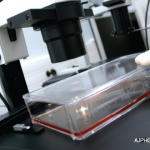Several enzymes can lead to GSD. These can be categorized in two ways: those that present with symptoms of exercise intolerance, cramps, and myoglobinuria, and those that commonly lead to more fixed weakness, “even though these are all conditions of the ability to break down the same energy source,” Dr. O’Rourke explained.
Lipid Disorders
Patients with lipid metabolism disorders may present with complaints of muscle pain or tightness induced by prolonged exercise and/or prolonged fasting, but they do not develop true muscle cramps or contractures and do not get a second wind. One common cause of myoglobinuria is a carnitine palmitoyltransferase II deficiency, which impedes the transport of long-chain fatty acids into mitochondria for energy and is characterized by dynamic exercise weakness, no second wind, and normal CK between attacks.
Mitochondrial myopathies present in adults as exercise intolerance with an exaggerated cardiopulmonary response to overcome the block in oxygen utilization, as well as extreme fatigue and dyspnea after little exertion.2,3 “These patients are breathing hard but just not making enough energy to move their muscles. When these individuals have a relatively high level of dyspnea at relatively low levels of exertion, that should be a clinical clue that they may have a mitochondrial myopathy,” Dr. O’Rourke said.
Assessment should include not only blood and urine tests, but also an electromyography in some patients and muscle biopsy with immunohistochemical staining. A muscle biopsy can determine whether the condition is a glycogen storage or lipid storage deficiency, and an excess of ragged red fibers can indicate a mitochondrial myopathy. Patients should also be screened for respiratory muscle involvement, because patients with certain metabolic myopathies “are at risk of aspiration and its attendant morbidity,” he said.
Drug therapy varies depending on the type of myopathy, but general recommendations include patient education, individualized physical therapy that can include resistance strength training to slow the rate of muscle strength loss, aerobic training for cardiovascular fitness, and avoidance of muscle lengthening or eccentric contractions, according to Dr. O’Rourke. Some physicians recommend dietary changes and supplements, depending on the type of myopathy.4
Kathy Holliman is a medical journalist based in New Jersey.
References
- Dankό K, Ponyi A, Constantin T, Borgulya G, Szegedi G. Long-term survival of patients with idiopathic inflammatory myopathies according to clinical feature: A longitudinal study of 162 cases. Medicine (Baltimore). 2004:83:35-42.
- Siciliano G, Volpi L, Piazza S, et al. Functional diagnostics in mitochondrial diseases. Biosci Rep. 2007;27:53-67.
- Albert DA, Cohen JA, Burns CM, et al. When should a rheumatologist suspect a mitochondrial myopathy? Arthritis Care Res (Hoboken). 2011;63:1497-1502.
- Di Mauro S, Mancuso M. Mitochondrial diseases: Therapeutic approaches. Biosci Rep. 2007;27:125-137.


